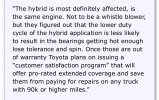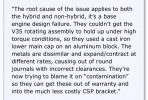I've been following this closely over the last few days and I think this situation looks pretty bad for Toyota at the moment though I am glad they've issued the recall and are working with owners.
The recall covers 2022 and 2023 Tundra and LX 600 gas-only models right now, and excludes hybrids. I don't know why because the Sequoia and Tundra iFORCE MAX models have both had engine failures. One theory I read was that Toyota has more data on the 2022 and 2023 gas models by volume, so the first stage of the recall is for those models but others can be added anytime. It seems like it's only a matter of time before the 2024s and hybrids are added as more are sold and the miles increase.
The theory about regular gas vs. premium gas has been debunked. Same for oil change intervals.
The theory that one random guy on the engine assembly line in Alabama wasn't adequately washing debris from the engine components during installation also seems to be disproven since this is happening to LXs, which are built at Tahara. The LS is a much lower volume vehicle, but it has also had engine failure issues and is also built at Tahara. If machining debris is the issue, it's a problem with Toyota's production process, seemingly not one specific case of human error, as it's occurring at two different plants with four different models.
A few technicians are starting to speak out online, and whether that's for attention or just to help concerned owners, their theories seem closer to making sense IMO.




The Tundra has had its fair share of issues but they aren't all related to this (For example, the turbo wastegates early in production were something totally different), but owners hearing knocking or stalling has often been a documented precursor to the engine failure, and that's been going on for two years with Toyota replacing various parts or rebuilding engines for impacted customers. This has been going on so long that the "machining debris" explanation just doesn't make sense to me -- that would have been easy to fix when the issue first popped up.
There have been reports of LSs, LXs, Tundras and Sequoias with spun bearings and the bottom end of the engine is burned and starved for oil. Whatever the cause might be, to me this is looking more like a potential design, process, or material defect than a production issue with debris. The Tundra being the highest volume vehicle to use this engine means it's taking the brunt of the bad PR, but if I owned an LX, Sequoia, GX 550 or LS 500 with the V35A, I'd be watching this issue to see what happens and what the remedy might be.
I have faith that Toyota will fix this for current and future owners, but it makes me wonder if a revised V35A could be on the horizon once the issue is diagnosed.





